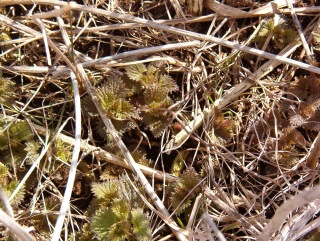FIRST PUBLISHED 4-23-18
Last week we had a blizzard, today we have our first veggies of spring coming up. By next Sunday we should have some ready to harvest. The vegetable in question is stinging nettle, which is cooked like spinach but is more nutritious.
This is how I got started with stinging nettle: I bought seeds for it from Richters Herb catalog. I planted it in the perennials section of my then-garden and it came up very well. In the next few years the plant spread— like a weed, which is what some people think it is. And it is a good thing that it spread. When I got Pilgrim geese, they pretty much chewed the original nettle bed down to the dirt.
Stinging nettle stings when you touch it with your bare hand. So most people use gloves when they handle it. Except my Serbian friends who pluck a leaf with their bare hands and eat it raw to show how tough they are. I’ve eaten a few leaves that way myself, but it’s better when you either cook it as a green veggie or dry it for a tea.
As a tea I felt it tasted more like a broth, so I think it would be great in soups. As a cooked veggie it can be used in any recipe for spinach. Both cooking and drying take away the sting of nettle.
It’s also great as livestock feed. Full of vitamins. Just cut some and let it dry. Great for goats and sheep. And when I am trying to eradicate stinging nettle from the places I DON’T want it, I throw a plant of nettle, roots and all, into the nearest chicken pen. They eat it like candy.
I’ve always felt like a failure as a gardener, so this year I decided to turn one of the nettle patches I have anyway into a semi-cultivated veggie patch. Of course my best patch is located in an alleyway between my sheep pens, but I decided it wasn’t too inconvenient.
This is what the bed looked like when I got started. You can see the dried stalks of the nettle plants, as well as one of the cats walking through the picture. I removed the old dried stalks and raked the bed to remove all the trash and dried grass from the new nettle bed.
Next step is to find other nettle patches that still have the seed heads dried on the top and gather them. There are some bare patches in the nettle bed, and I plan to cultivate the soil bare-spots and scatter a little of the nettle seed.
I’m also preparing a new nettle patch in my ‘forest garden.’ I’ve raked up an area and plan to transplant one nettle plant. I am also going to scatter a little nettle seed around the transplanted nettle. I’m not digging up the soil or anything. The stinging nettle seems able to compete with other plants quite well.
When the harvest begins, I am going to dry a supply for tea and for adding to soups, and I’m going to freeze some for use as a spinach-substitute. Now, I never ate cooked spinach or any other kind of cooked green growing up. I just never learned to like cooked greens. But I found some good recipes for cooked spinach that add other ingredients other than just spinach and cooking water, and I’m going to test them with nettles.
Harvesting: The best nettle is the young plants a few inches high in early spring. But you can also harvest the tender leaves from the top later in the year. Or any leaves. One cup of cooked nettle has 6.6 grams of carbs, so don’t eat superlarge portions if you are on a ketogenic/low-carb diet. Nutrition facts on stinging nettle.
Nettle growing links:

